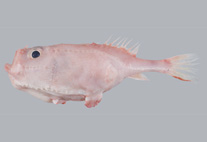Abstract
Pseudophilautus stellatus (Kelaart 1853) has been rediscovered from the Peak Wilderness, Central Hills of Sri Lanka. The species, till now known only from its lost holotype, was the first shrub frog described from Sri Lanka, and had not been reported since then. It was thought to have become extinct for nearly 157 years, being the amphibian species "lost" for the longest amount of time. Here we designate a neotype from the material collected at what we consider its type locality, having considered characters of the lost holotype and provide a complete description. We have conducted a molecular phy-logenetic analysis, on which basis the species is well differentiated from all other Pseudophilautus sequenced so far, and placed in a clade together with P. femoralis, P. frankenbergi, P. mooreorum, and P. poppiae.
References
Biju, S.D., Shouche, Y., Dubois, A., Dutta, S.K. & Bossuyt, F. (2010) A ground-dwelling rhacophorid frog from the highest mountain peak of the Western Ghats of India. Current Science, 98, 1119–1125.
Bossuyt, F. & Dubois, A. (2001) A review of the frog genus Philautus Gistel, 1848 (Amphibia, Anura, Ranidae, Rhacophorinae). Zeylanica, 6(1), 1–112.
Bossuyt, F., Meegaskumbura, M., Beenaerts, N., Gower, D.J., Pethiyagoda, R., Roelants, K., Mannaert, A., Wilkinson, M., Bahir, M.M., Manamendra-Arachchi, K., Ng, P.K.L., Schneider, C.J., Oommen, O.V. & Milinkovitch, M.C. (2004) Local endemism within the Western Ghats–Sri Lanka Biodiversity Hotspot. Science, 306, 479–481. http://dx.doi.org/10.1126/science.1100167
de Alwis, S.M.D.A.U., Dayawansa, P.N., How, R., Singhakumara, B.M.P., Weerakoon, D. & Wijesinghe, M.R. (2007) Biodiversity Baseline Survey: Peak Wilderness Sanctuary. In: Green, M.J.B. (ed.), Consultancy Services Report ARD Inc in association with Infotech IDEAS and GREENTECH Consultants. Sri Lanka Protected Areas Management and Wildlife Conservation Project (PAM&WCP/CONSULT/02/BDBS), (Prepared for: Department of Wildlife Conservation, Ministry of Environment and Natural Resources, Colombo), 44 pp.
Felsenstein, J. (1985) Confidence limits on phylogenies: an approach using the bootstrap, Evolution 39, 783–791. http://dx.doi.org/10.2307/2408678
Frost, D.R., Grant, T., Faivovich, J.N., Bain, R.H., Haas, A., Haddad, C.L.F.B., De Sa, R.O., Channing, A., Wilkinson, M., Donnellan, S.C., Raxworthy, C.J., Campbell, J.A., Blotto, B.L., Moler, P., Drewes, R.C., Nussbaum, R.A., Lynch, J.D., Green, D.M. & Wheeler, W.C. (2006) The Amphibian Tree of Life. Bulletin of the American Museum of Natural History, 297, 1–370. http://dx.doi.org/10.1206/0003-0090(2006)297[0001:TATOL]2.0.CO;2
Goebel, A.M., Donnelly, J.M. & Atz, M.E. (1999) PCR primers and amplification methods for 12S ribosomal DNA, the control region, cytochrome oxidase I, and cytochrome b in bufonids and other frogs, and an overview of PCRprimers which have amplified DNA in amphibians successfully. Molecular Phylogenetics and Evolution, 11, 163–199. http://dx.doi.org/10.1006/mpev.1998.0538
Günther, A. (1859) Catalogue of the Batrachia Salientia in the collection of the British Museum. Taylor & Francis, London, 160 pp.
Günther, A. (1872) Descriptions of some Ceylonese reptiles and batrachians. Annals and Magazine of Natural History, Series 4 (9), 85–88.
IUCN Sri Lanka & Ministry of Environment and Natural Resources Sri Lanka. (2007) The 2007 National Red List of Threatened Fauna and Flora of Sri Lanka. IUCN Sri Lanka and Ministry of Environment and Natural Resources Sri Lanka, 148 pp. http://dx.doi.org/10.4038/jnsfsr.v36i1.140
Kelaart, E.F. (1853) Prodromus faunae zeylanicae; being contributions to the zoology of Ceylon. Published by the author, Colombo, 197 pp.
Kimura, M. (1980) A simple method for estimating evolutionary rates of base substitutions through comparative studies of nucleotide sequences. Journal of Molecular Evolution, 16,111–120. http://dx.doi.org/10.1007/bf01731581
Li, J., Che, J., Murphy, R.W., Zhao, H., Zhao, E., Rao, D. & Zhang, Y. (2009) New insights to the molecular phylogenetics and generic assessment in the Rhacophoridae (Amphibia: Anura) based on five nuclear and three mitochondrial genes, with comments on the evolution of reproduction. Molecular Phylogenetics and Evolution, 53, 509–522.
http://dx.doi.org/10.1016/j.ympev.2009.06.023Manamendra-Arachchi, K. & Pethiyagoda, R. (1998) A synopsis of the Sri Lankan Bufonidae (Amphibia: Anura) with description of new species. Journal of South Asian Natural History, 3, 213–248.
Manamendra-Arachchi, K. & de Silva, A. (2004) Adenomus kandianus. In: IUCN 2011. IUCN Red List of Threatened Species. Version 2011.2. Available from www.iucnredlist.org (accessed 28 January 2012).
Manamendra-Arachchi, K., Pethiyagoda, R., Dutta, S. & de Silva, A. (2004) Pseudophilautus stellatus. In: IUCN 2012. IUCN Red List of Threatened Species. Version 2012.1. Available from www.iucnredlist.org (accessed 02 October 2012).
Manamendra-Arachchi, K. & Pethiyagoda, R. (2005) The Sri Lankan shrub frogs of the genus Philautus Gistel, 1848 (Ranidae: Rhacophorinae), with description of 27 new species. The Raffles Bulletin of Zoology, 12, 163–303.
Meegaskumbura, M. & Manamendra-Arachchi, K. (2011). Two new species of shrub frogs (Rhacophoridae: Philautus) from Sri Lanka. Zootaxa, 2747, 1–18. http://dx.doi.org/10.4038/tapro.v1i2.2766
Meegaskumbura, M., Bossuyt, F., Pethiyagoda, R., Manamendra-Ararchchi, K., Bahir, M., Milinkovitch, M.C. & Schneider, C.J. (2002) Sri Lanka: an amphibian hotspot. Science, 298, 379.
Meegaskumbura, M., Manamendra-Arachchi, K., Schneider, C.J. & Pethiyagoda, R. (2007) New species amongst Sri Lanka’s extinct shrub frogs. Zootaxa, 1397, 1–15.
Pethiyagoda, R. (2005) Exploring Sri Lanka’s biodiversity. The Raffles Bulletin of Zoology, 12, 1–4.
Stuart, S.N., Hoffmann, M., Chanson, J.S., Cox, N.A., Berridge, R.J., Ramani, P. & Young, B.E. (2008) Threatened Amphibians of the World. Lynx Editions, 776 pp.
Swofford, D.L. (2002) PAUP*.Phylogenetic Analysis Using Parsimony (*and Other Methods). Version 4, Sinauer Associates, Sunderland, Massachusetts.
Tamura, K., Dudley, J., Nei, M. & Kumar, S. (2007) Molecular Phylogenetics and Evolution, 24, 1596.
http://dx.doi.org/10.1093/molbev/msm092Wickramasinghe, L.J.M., Vidanapathirana, D.R. & Wickramasinghe, N. (2012a) Back from the dead: The world’s rarest toad Adenomus kandianus rediscovered in Sri Lanka. Zootaxa, 3347, 63–68.
Wickramasinghe, L.J.M., Munindradasa, D.A.I. & Fernando, P. (2012b) A new species of Polypedates Tschudi (Amphibia, Anura, Rhacophoridae) from Sri Lanka. Zootaxa, 3498, 63–80.
Yu, G., Rao, D., Zhang, M. & Yang, J. (2009) Re-examination of the phylogeny of Rhacophoridae (Anura) based on mitochondrial and nuclear DNA. Molecular Phylogenetics and Evolution, 50, 571–579. http://dx.doi.org/10.1016/j.ympev.2008.11.023
Yu, G., Zhang, M. & Yang, J. (2010) Generic allocation of Indian and Sri Lankan Philautus (Anura: Rhacophoridae) inferred from 12S and 16S rRNA genes. Biochemical Systematics and Ecology, 38, 402–409. http://dx.doi.org/10.1016/j.bse.2010.03.011

